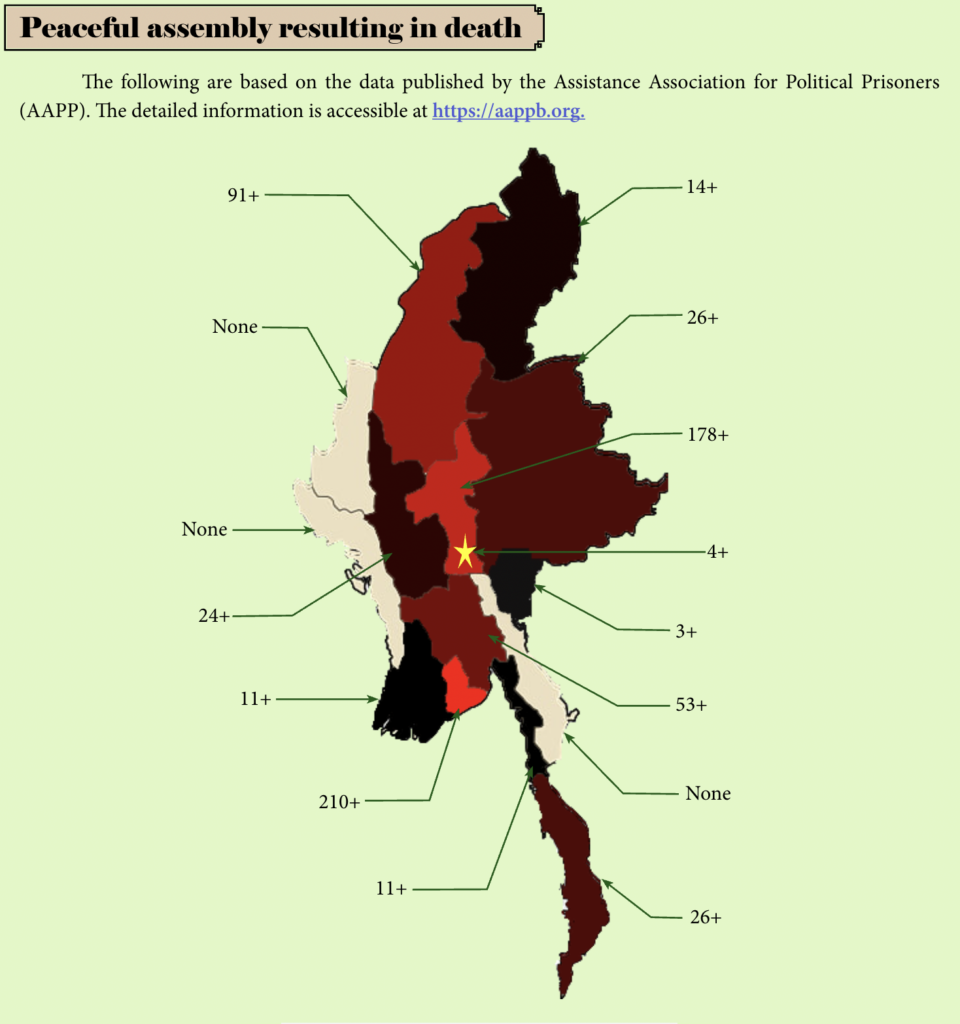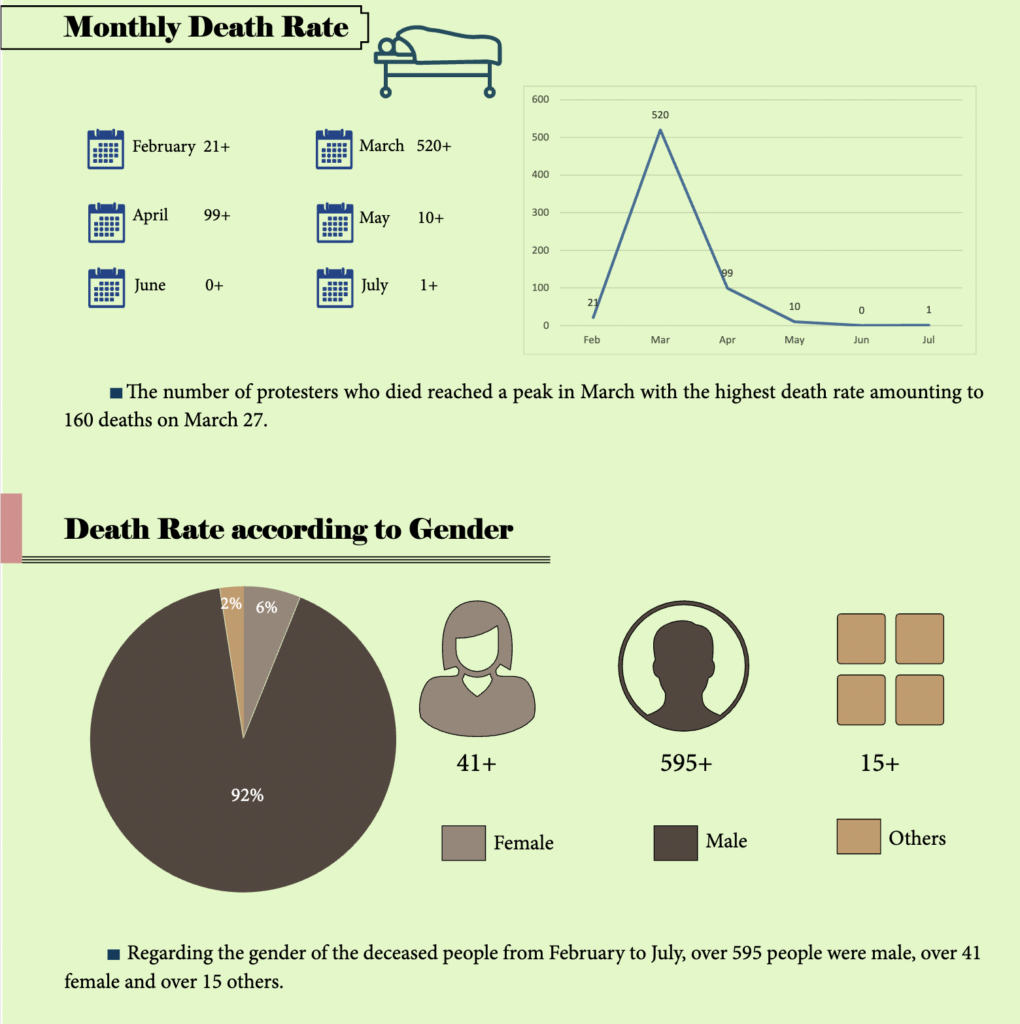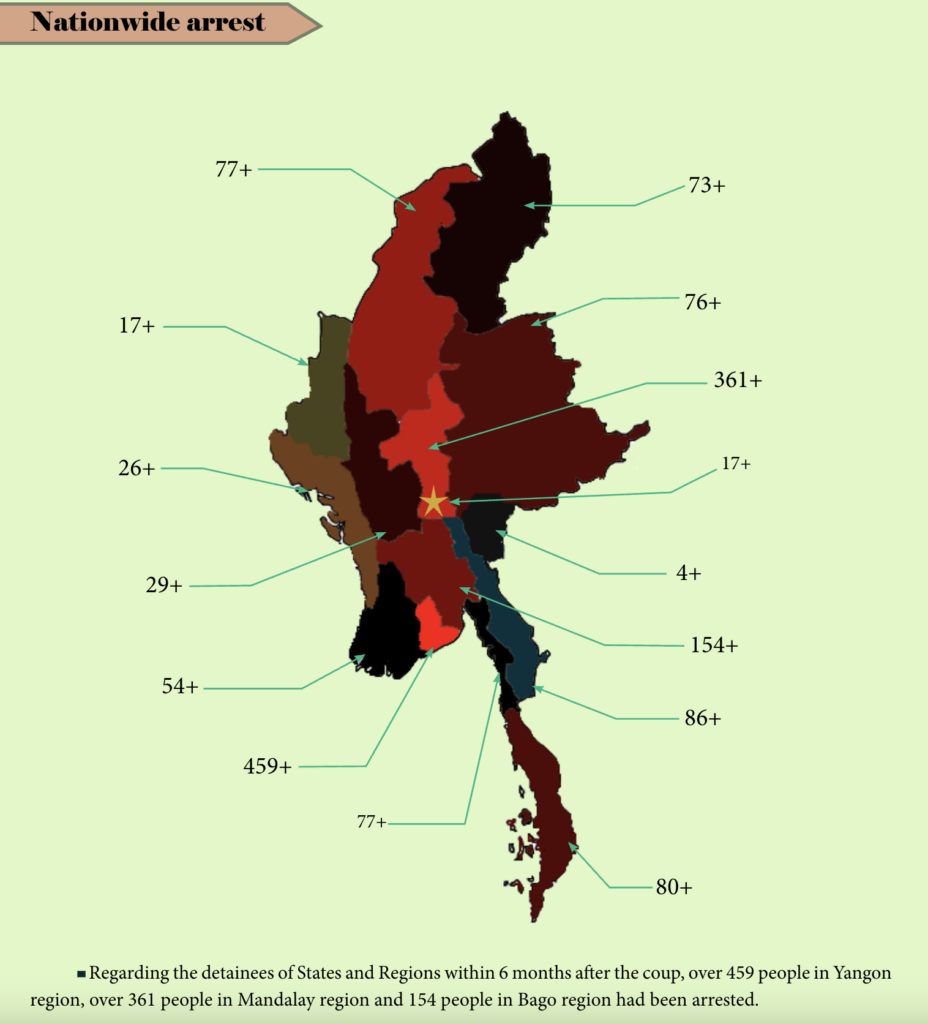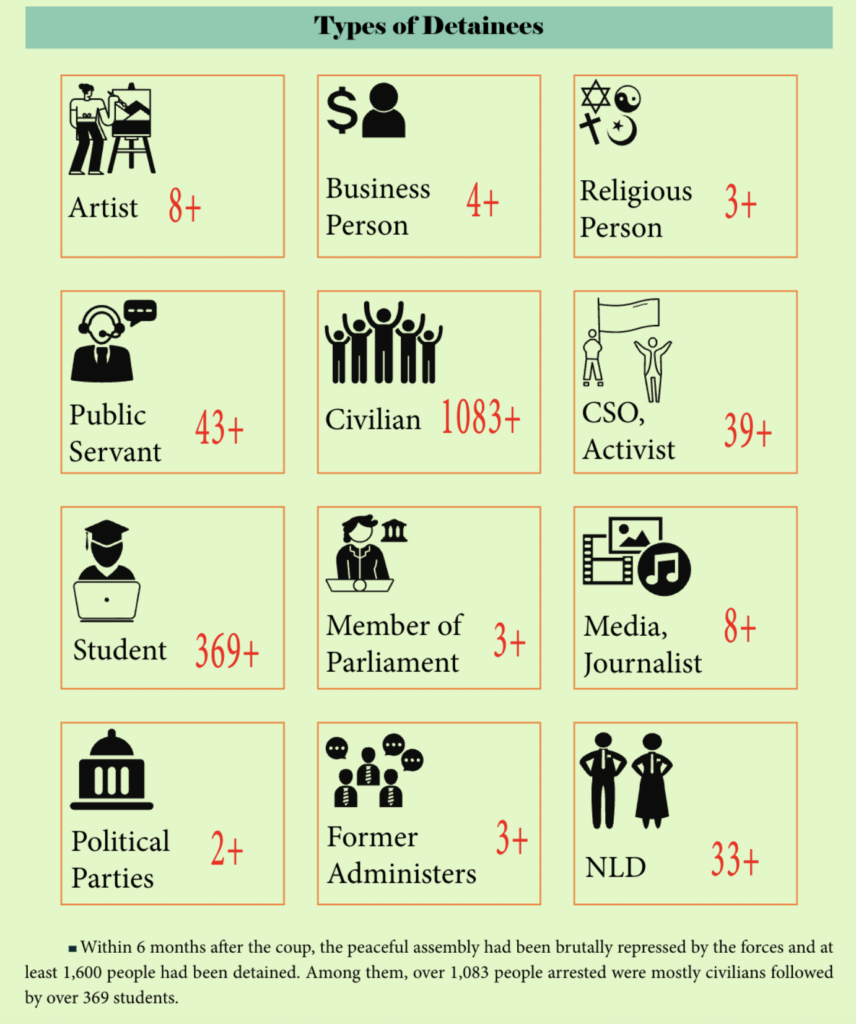Peaceful assembly
The right of peaceful assembly shall be recognized according to article 21 of the International Covenant on Civil and Political Rights (ICCPR). The right of peaceful assembly protects the nonviolent gathering, principally expressive ones with a specific purpose. Peaceful assembly means nonviolent gathering with common expressive purpose either outdoors or indoors or online at public or private places. Those assemblies are in various forms such as protests, demonstrations, rallies, meetings, strikes, processions, sit-in protests, online assemblies, and flash mobs. Even if someone or some of the participants in such an assembly or protest do violence, that whole assembly cannot be regarded as a violent one.It has been stated in the General Comment No. 37 of ICCPR that only if the participants in an assembly do extensive and considerable violence, that kind of assembly can be regarded as an un-peaceful assembly.
According to the Armed Conflict Location & Event Data Project (ACLED) which had studied over 4,700 demonstrations opposing the Junta in Myanmar from February to June, 98% of the demonstrations were peacefully held. With the reason that there was fraud in the vote of the November 2020 Election, Junta General Min Aung Hlaing seized power and detained the civilian government officials including President U Win Myint and State Counsellor Daw Aung San Suu Kyi on February 1, 2021. Since that time, millions of people from cities, towns, villages, and Burmese people in abroad have protested the Military Junta. The Pot-banging campaign which is the first campaign against the Military coup was commenced across the country on February 2.
Peaceful assembly in Myanmar before and after the coup
The peaceful assembly has been suppressed since the civilian government led by the National League for Democracy party (NLD) and severely inhibited after the coup. During the last government term, the peaceful assemblies had been violated such in events that peaceful poetry protesters were charged under Section 19 of the Peaceful Assembly and Peaceful Procession Law, the one who protested to execute the Military was charged under penal code of 505 (a), in addition to Section 20 of the Peaceful Assembly and Peaceful Procession Law and was sentenced in prison, the people in charge who held the Karen Martyr Day were sentenced in prison for organizing the event and using the word ‘Karen Martyr’, the students and youth who asked to restore the internet access in the Rakhine State were charged under the penal code of 505 (b), Section 25 of the Natural Disaster Management Law, in addition to Section 19 of the Peaceful Assembly and Peaceful Procession Law.
On February 4 after the coup, the youth demonstrated in front of the University of Medicine, Mandalay and Sanchaung Township, Yangon, demanding to release the detained leaders and to restore the democracy. On the very first 3 days of the coup, anti-coup campaigns such as poster campaigns and the red ribbon campaigns by the civil servants from the different Departments such as Education, Health and Transport were demonstrated. The peaceful protest had accelerated countrywide from the large cities, towns to the villages opposing the coup from February 4 and 5 onward.
The use of force by the Military Junta
Among the participants of the first protest in Mandalay, Ko Min Nyi Nyi Tun, Ko Ye Win Tun, Ko Pyae Sone Aung and Ko Saw Okkar Oo from the Student Union were charged and detained under Section 19 of the Peaceful Assembly and Peaceful Procession Law and Section 25 of the Natural Disaster Management Law. As the Pot-banging Campaign was powerfully participated nationwide by hitting the pot and pan if you were at home and by honking if you were on the road, there were detainees since February 4. At least 30 people in Mandalay Region, Naypyidaw, Yangon Region, Ayeyarwady Region and Chin State were detained and prisoned due to the pot banging. Among them, more than 10 people were detained under Section 47 of the Police Act and sentenced to 7 days in prison. In Hakha of Chin State, some people were charged under Section 34 of the Police Act and sentenced to 8 days in prison and a fine of 50 kyats. The ones who participated in the Pot-banging Campaign were investigated by the police and the respective quarter head. Some were released by signing self-warrant or by the negotiation of the residents. As the campaign was nationwide and not easy to detain and charge, gun fires were made to threaten people in the wards and villages. As an example, the soldiers of the State Administered Council entered the wards, while they were swearing and firing, and detained the ones striking the pot and pan to suppress the public Pot-banging Campaign.
After February 5 and 6, the protests led by the youth in Yangon, Mandalay, Naypyidaw, Monywa,Taunggyi and Magway became stronger and stronger. Till that time, the protests were handled according to the International Law for handling the peaceful protest by setting three lines to disperse. Then on February 8 in Naypyidaw, the police force of the Military Junta used water cannon and shot the people shouting, “We don’t want Military Junta” and some were injured. On February 9, over 60 people in Mandalay were arrested in one day. The police force started to use the real bullet in dispersing the protest at the Tha-pyay-kone round-about. This resulted in at least 5 people being injured, and Ko Soe Wai and Ma Mya Thwae Thwae Khaing were shot in the chest and head respectively. Ma Mya Thwae Thwae Khaing suffered from brain-dead due to the gunshot and deceased on February 19. The public frustration on the Military Junta had risen and as a result, the roads were filled with millions of protesters. As the protest became stronger, the police and soldiers of the SAC violently dispersed and arrested the public by using water cannons, sound grenades, and tear gas, and shoot the protesters with rubber and real bullets. In addition to the investigation and arrest of the young people who drew street graphics such as “We want justice”, “Spring Revolution”, “We need Democracy”, the protesters were brutally killed with a headshot. Although the pub-lic protests seem to be weakened as activists and the strike leaders were detained, the protests are still going onward.

Being participated in the peaceful protest, at least 651 people were killed mostly in Yangon Region, Mandalay Region and Sagaing Region during 6 months after the coup from February 1 to July 31. There was no loss of life by use of force on the protests in Kayin State, Chin State and Rakhine State. For Kayin State, no brutal crackdown on the protests was taken place as the KNU guarded the protesters. Even though people died by the clashes in Chin State, we have found that no one died by using lethal force on the protests. In Rakhine State, the protesters had been arrested but there was no violent and arbitrary crackdown.





The associated detainment of the protesters
The data presented in this research is based on the ones who had been arrested during the protest. Although the young people were not detained during the protest, many of them had been investigated and arrested in the wards after the protests. On March 13, the collective sit-in strike had been dispersed and then about 30 young students hid in Daw Pyone’s house for a while. Later, the riot police and soldiers of the SAC arrived and shot Daw Pyone at the head as she kept the young students. Similar cases had happened many times.
Family arrested as the strike leader was not found
On June 13, the Military junta arrested his wife, 5-year-old and 18-year-old daughters as they could not find Ko Soe Htay, the strike leader who lived at the Bamon ward, Mogok, Mandalay Region. The oldest daughter, Ma Theint Sandi Soe, is a 3rd-year student, specializing in Law and has suffered from Systemic Lupus Erythematosus (SLE). As she has been investigated at Interrogation many times, her health became worsen. Su Htet Wine, a 5-year-old kid, had been released after 18 days in custody on June 30. The child had stayed in prison for a long time and got trauma because of the people who made her sit in a squatting position as punishment, and she hates those people. Ko Soe Htay’s wife and his daughter had been charged under 505(a) and sentenced to 3 years in prison at Mogoke Court on July 13.
According to the Ayeyarwady news, the SAC has detained the family members including the child as a hostage, amounting to 177 people within 7 months after the coup, and 40 people had been released and 137 people are still under imprisonment. Among the hostage, the 2 years old detainee is the youngest.
The strike leader, Ko Wai Moe Naing, was detained after being hit by a car and arrested with 10 charges
The strike leader, Ko Wai Moe Naing who expressed opposition to the Military Junta had led many protests in Monywa. On April 15, the military men hit and arrested Ko Wai Moe Naing with a civilian car from the opposite lane while he was participating in the cycle strike. According to the eyewitness’s talk to the media, the bike fell, and Ko Wai Moe Naing had been beaten and was arrested. He was taken to the North-west military command base and his photo with swollen bruises spread on social media one day after being arrested.
The SAC accused Ko Wai Moe Naing of 10 charges. They are Section 25 of the Natural Disaster Management, Penal code of 302 for committing murder, Penal code of 114 for abettor present, Penal code of 325 for voluntarily causing grievous hurt, Penal Code of 342 for wrongful confinement, Penal code of 395 for armed robbery, Penal Code of 505(a) for stimulating the breach of peace, Section 17(1) of the Unlawful Association Act, Penal code of 124 for treason and Penal code of 511 for committing offences punishable with imprisonment.
The SAC also charged Dr Tay Zar San who is a famous anti-coup protest leader in Mandalay under Penal Code of 505(a) and issued an arrest warrant for a 100 lakhs award.
Protest in prisons and dissolution
On July 23, the protest in the Insein prison initiated with the scream of the military government rejection. According to the AAPP statement, the protest started at the separate female detention block and spread to the whole prison and some staffs of the Prison Department also joined the protest. The people who participated in the protests opposing the coup were detained in a separate block. The main reason for the protest was that the authority neglected the worse condition of the COVID-19 infection of the prisoners during the severe Covid-19 third wave, enough health care was not provided for the staff of the Prison Department, and no political prisoners was released with Amnesty on June 30. The three chants at the prison protest are that 1) the release of the political prisoners, 2) the right to proper medical treatment and 3) the lessening of the strict disciplines. The prisoners sang Thway-thisar1 song and yelled those slogans.
After the protest, the soldiers of the SAC entered the prison and used force to violently disperse the protesters. Those who led the protests including the executive committee member of the Student Union, Ko Zaw Htet Naing @Sitt Naing and other 20 political prisoners had been consigned to solitary confinement.Due to the brutal crackdown, at least 8 people were deadly injured. Besides, the forces were deployed at the Oh-bo prison in Mandalay to stop the spread of protest in prison on July 23. After the protest in prison, the disciplines inside the prison became stricter and it became difficult to support food and medicine and to request permission letters for prison visits and others had been sent to the township prisons.
In conclusion, the whole public who opposed the Military coup expressed their desire and participated in the protests wherever they are. Although the number of protests has become lower when compared to that of February and March as the SAC violently dispersed the protest and shot with the real bullet, people still participated in the protests till now. People both inside and outside of Myanmar try to execute the SAC who threaten the right to peaceful procession and right to express their will, right to livelihoods, wealth, and security. The right to expression and protest is neither crime nor a fatal offence. As a result, we have found that the last choice for the public to remove the SAC who only focus on their power and do not consider the life of the public is the revolution.
Research Methodology
n this research, the data and cases are collected from daily monitoring of the online media and information of the AAPP. Based on the analysis and inference of the data, this research documents the violation on the peaceful assembly. Descriptive research method is used for the presentation of the data.
